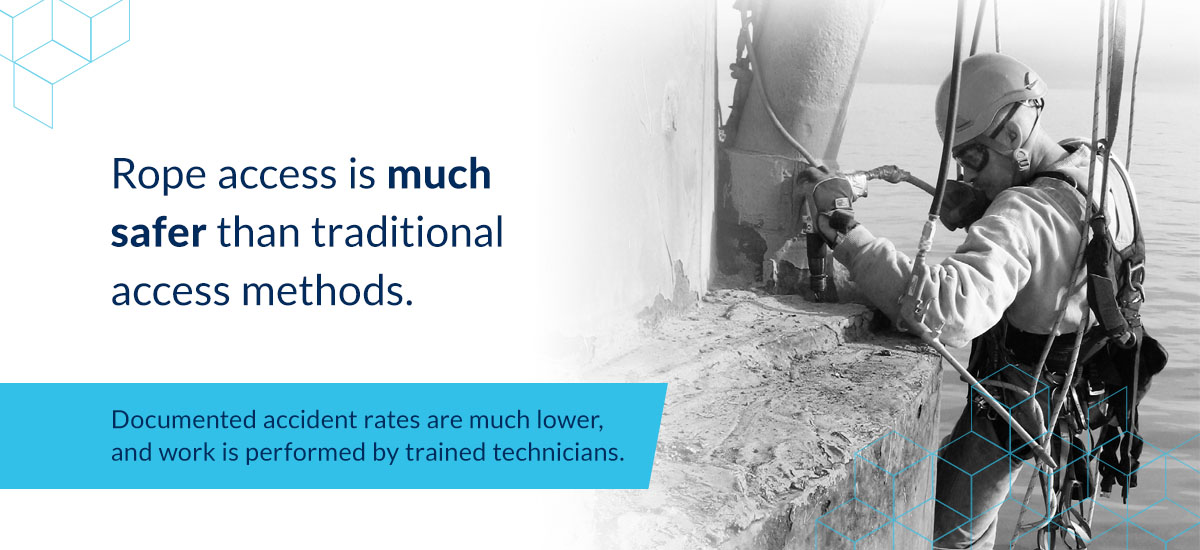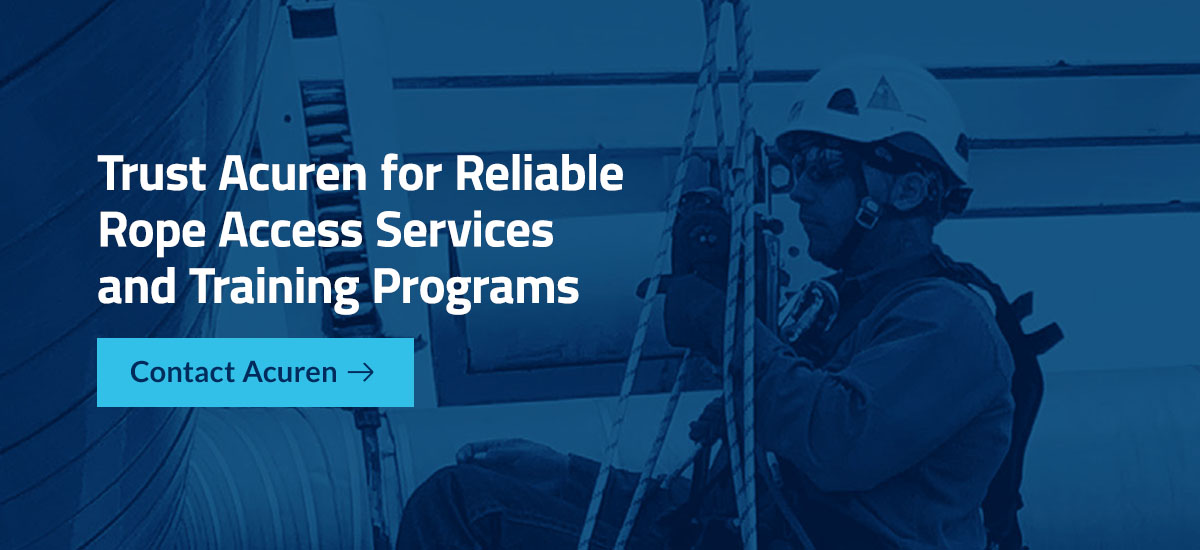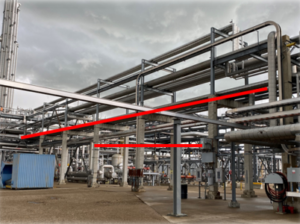
Rope access is an alternative to executing work at height. Rather than traditional methods such as scaffolding or ariel lifts, industrial rope access technicians can often execute work scopes at height more efficiently. Learn more about rope access and the benefits from the safest and largest provider in North America.
What Is Rope Access?
Using similar equipment to rock climbers or arborists, rope access uses industrial climbing equipment to reach at-height work scopes. Industrial rope access can access almost any location and even implement engineered alternative access platforms to prevent unnecessary safety risks or additional costs.
How Rope Access Works
When planning to execute a work scope at height, rope access is often chosen due to its efficiency and safe performance. The following equipment is necessary for rope access work:
- Ropes: Rope access work requires dynamic ropes that stretch slightly. There are two ropes — a working rope and a backup rope to provide redundancy in case the primary rope fails. Ropes must meet standards set by Industrial Rope Access Trade Association (IRATA) International.
- Ascenders and descenders: These mechanical devices allow technicians to ascend and descend the ropes at a controlled speed.
- Harnesses: Full-body harnesses are commonly used.
- Anchor points: Anchor points are attached to the structure and designed to support the worker and their equipment.
- Lanyards and energy absorbers: Lanyards link the harness to the anchor point. There are several types, including shock-absorbing and positioning lanyards. Energy absorbers are integrated into lanyards as part of the overall fall protection system. It activates during a fall to absorb the impact.
- Helmets and gloves: Helmets protect technicians from hits on the head and flying debris. Gloves improve grip and protect a worker’s hands.
Other essential pieces of equipment include connectors, footloops and pulleys.
Tasks Made Easier With Rope Access
Rope access makes the following tasks easier and more efficient:
- Inspecting equipment at high locations such as smoke stacks, wind turbines or any structure.
- Repairing and maintaining equipment such as vessels, tanks piping, bridges or buildings.
- Surface preparation, sandblasting, laser cleaning and coatings.
- Installing or replacing equipment on tall buildings or other infrastructure.
- Conducting inspections using nondestructive testing methods.
- Rescuing people in confined spaces such as vessels, towers or tanks.
Rope access can perform almost any work scope at height. Rope access and alternative access methods can reduce the safety risk, scheduled downtime and cost of any project.
Is Rope Access Safe?

While any work at height comes with inherent risks, rope access is not dangerous when workers are properly trained and follow industry standards. It’s much safer than traditional access methods. Documented accident rates are much lower, and work is performed by trained technicians.
IRATA International is responsible for regulating rope access training. Training occurs in accordance with IRATA International’s Training, Assessment and Certification Scheme (TACS). After training, technicians take an independent assessment. Upon successful completion, they become registered with IRATA and are issued a log book and identification card.
There are three certification levels:
- Level 1: Level 1 technicians can perform a specific range of tasks under the supervision of a Level 3 technician.
- Level 2: In addition to having Level 1 skills, Level 2 technicians have more complex skills. They remain supervised by a Level 3 technician.
- Level 3: Level 3 technicians can demonstrate Levels 1 and 2 skills and knowledge. They also have extensive knowledge of rigging and rescue techniques and can take complete responsibility for rope access safety in work projects. They understand relevant work techniques and legislation, hold a first-aid certificate, and understand IRATA International’s TACS.
Technicians are grouped according to their experience and level of assessment as described in IRATA International’s TACS.
Companies wishing to become IRATA members must also confirm their adherence to guidelines via audits. IRATA members reinforce their commitment to safety by providing clients with method statements for any job requiring rope access. These documents describe procedures and safety measures in detail, including potential hazards and necessary equipment. This proactive process contributes to the low documented accident rates.
The Society of Professional Rope Access Technicians (SPRAT) also offers certifications for rope access technicians. Similarly, there are three levels of certification that rope access technicians can achieve through advanced training programs.
Why Use Rope Access: 5 Benefits to Consider
In addition to safety, industrial rope access offers the following benefits:
- Cost: Rope access requires less equipment and fewer workers, making it much more affordable than traditional options like scaffolding. Plus, it’s much less intrusive.
- Access: Rope access is extremely flexible and allows technicians to reach difficult areas and work in confined spaces. Technicians can also get much closer to the structure.
- Speed: Constructing scaffolding is a time-intensive, days-long process. Rope access setup takes minutes or hours, depending on the project size.
- Convenience: Rope access mitigates the possibility of damage to the structure. With scaffolding and other access methods, building facades may undergo damage.
- Environmental impact: With fewer people traveling to the site and no need for heavy equipment, rope access is more environmentally friendly than other methods.
Industries That Benefit From Rope Access Services
Consider the following seven industries where rope access is used:
- Building and infrastructure: Whether working on buildings, bridges or other large-scale infrastructure, rope access provides unmatched access. It’s effective for window cleaning, structure inspections and repairs.
- Oil and gas: Because there’s no need for ground access, rope access is beneficial for maintenance, inspection and repair tasks on offshore drilling rigs and refineries.
- Wind: Workers can reach the tips of turbine blades to complete thorough inspections and repairs.
- Aerospace: Technicians can inspect, maintain and repair hard-to-reach aircraft components, such as the fuselage and wings.
- Power generation: Maintaining, repairing and inspecting power stations and storage depots becomes more efficient with rope access. Technicians can navigate complex structures and maximize uptime. There’s also a reduced risk of ignition compared to conventional equipment.
- Mining: Technicians can access tight spaces within mine shafts. They can reach support beams, inspect high ceilings and apply sealant to cracks in the walls.
- Chemical: Keep your chemical tower working properly with maintenance and inspections. Technicians can ascend to the top of the tower to make repairs or complete scheduled maintenance tasks.
Trust Acuren for Reliable Rope Access Services and Training Programs
When carried out correctly by experienced technicians, rope access is safer, more affordable and more efficient than traditional access methods.
Whether you need skyscraper inspections or to de-ice high-up bridge cables, you can trust Acuren to get the job done quickly, safely and cost-effectively. We have more than four decades of experience and employ over 5,500 professionals across 110 North American locations.
You can also turn to Acuren for comprehensive rope access training. Our program offers certification for all three IRATA levels and also adheres to SPRAT standards. With assistance from seven certified Tacten trainers in the United States and Canada, we instruct more than 200 students annually. Our program is ideal for individuals earning certifications for the first time, upgrading their certification or getting recertified.
Download our Rope Access Services brochure to learn more about how we create tailored strategies for our clients. You can also request a quote for service or enroll in our advanced rope access training services.



